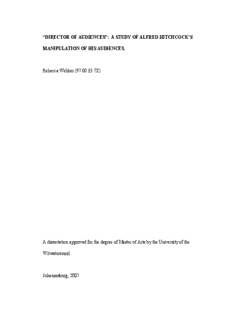
“director of audiences”: a study of alfred hitchcock's - WIReDSpace PDF
Preview “director of audiences”: a study of alfred hitchcock's - WIReDSpace
“DIRECTOR OF AUDIENCES”: A STUDY OF ALFRED HITCHCOCK’S MANIPULATION OF HIS AUDIENCES. Rebecca Webber (97 00 33 7X) A dissertation approved for the degree of Master of Arts by the University of the Witwatersrand. Johannesburg, 2007 Abstract This Master’s thesis identifies and elucidates upon the motifs/themes/images, which Hitchcock utilized in his films to ultimately manipulate and thereby direct his audience’s perception and understanding of his films’ narratives. The devices that are described and investigated in detail in this thesis are found to be recurrent in most of Alfred Hitchcock’s films. That highlights the question: why are they recurrent? What purpose do they serve? I believe that the answer to these questions is that these devices were used by Hitchcock to serve the end of manipulating the audience. The efficacy of these devices as used by Alfred Hitchcock is elaborated on in each chapter that addresses each motif in turn. Each chapter which deals with one of the motifs Alfred Hitchcock used in his manipulation of his audience contains examples from films and investigates how the motifs are used within each film to manipulate audience comprehension. These examples are strengthened with theory from academics, theorists and critics who have made a life-long study of Hitchcock. My theoretical framework includes audience research and Metz’s theory of ‘suturing’ which addresses the meaning of camera position and the different point of view that the audience take up. By means of this research I aim to explain the way in which Hitchcock consummately manages to manipulate the audience to follow ‘red herrings’ and ultimately surprise the audience. This thesis acknowledges the premise that all film directors manipulate the audience and does not attempt to persuade the reader that Hitchcock was unique in this. It does aim to explore and explain how Hitchcock’s unique use of specific motifs was utilized in order to manipulate audiences. This thesis resulted in my understanding Hitchcock’s method of directing his audiences as much as his films and I think that in a broader context explains the use and need (both Hitchcock’s and the films narrative’s) for the repetitive devices for which Hitchcock is renowned, rather than merely investigating them as isolated pieces in Hitchcock’s films. I would suggest that there is evidence in these films of a repetition compulsion, as if the films are attempting to solve a conundrum very much in the way that academics have attempted to solve the conundrum that is the work of Alfred Hitchcock. Search words: Hitchcock, director, film, thriller, manipulation, audience, double, Psycho, scatology, voyeurism, auteur, spectator theory, Truffaut, narrative, scopohilia. Declaration I declare that this dissertation is my own unaided work. It is submitted for the degree of Master of Arts in the University of the Witwatersrand, Johannesburg. It has not been submitted before for any other degree or examination in any other university. day of 2006 Rebecca Webber Dedication To my family with sincere thanks for their love and encouragement during the writing of this thesis Acknowledgements I would like to acknowledge and thank my supervisor, Prof. Jane Taylor for her support and intellectual assistance in the preparation of this dissertation. CONTENTS 1. Parts of the thesis 1.1 Title Page………………………………………………………………….1 1.2 Abstract…………………………………………………………………....2 1.3 Declaration……………………………………………………..………….4 1.4 Dedication…………………………………………………..……………..5 1.5 Acknowledgements……………………………………..…………….…...6 1.6 Contents………………………………………………………..…………..8 2. Introduction………………………………………………………………10 3. Audience…………………………………………………………………15 3.1 Understanding the Audience…………………………………………..…22 4. Use of the ‘Star System’…………………..………………………………….37 4.1 Casting and Physical Types……………….....………………………37 5. The Homosexual Other ……………………………………………………….49 6. The Role of Women…………………..……………………………………...63 6.1Scopophilia………………………………………………………………..63 6.2 Performances within Performances………….…..……………………….64 6.3 Hitchcock’s Cameos...…………………………………………………..77 6.4 The Figure of the Voyeur…………………………………………...…..82 6.5 The Elusive Blonde…………………..………………………………….91 6.6 Characters present in absence…………………………………..………100 6.6.1 The Vanishing Lady………………………………..…………………100 6.6.2 The Mother Figure……………………………………………………110 7. Scatology………………………………………………………………....127 8. The Double……………………………………………………………….168 9. Conclusion……………………………………………………………....182 10. References……………………………………..………………………..186 11. Bibliography…………………………………………………………….191 Appendix A…………………………………………………….…………...200 Appendix B…………………………………………………………….…...208
Description: